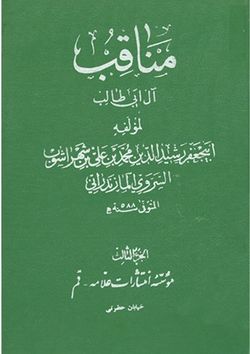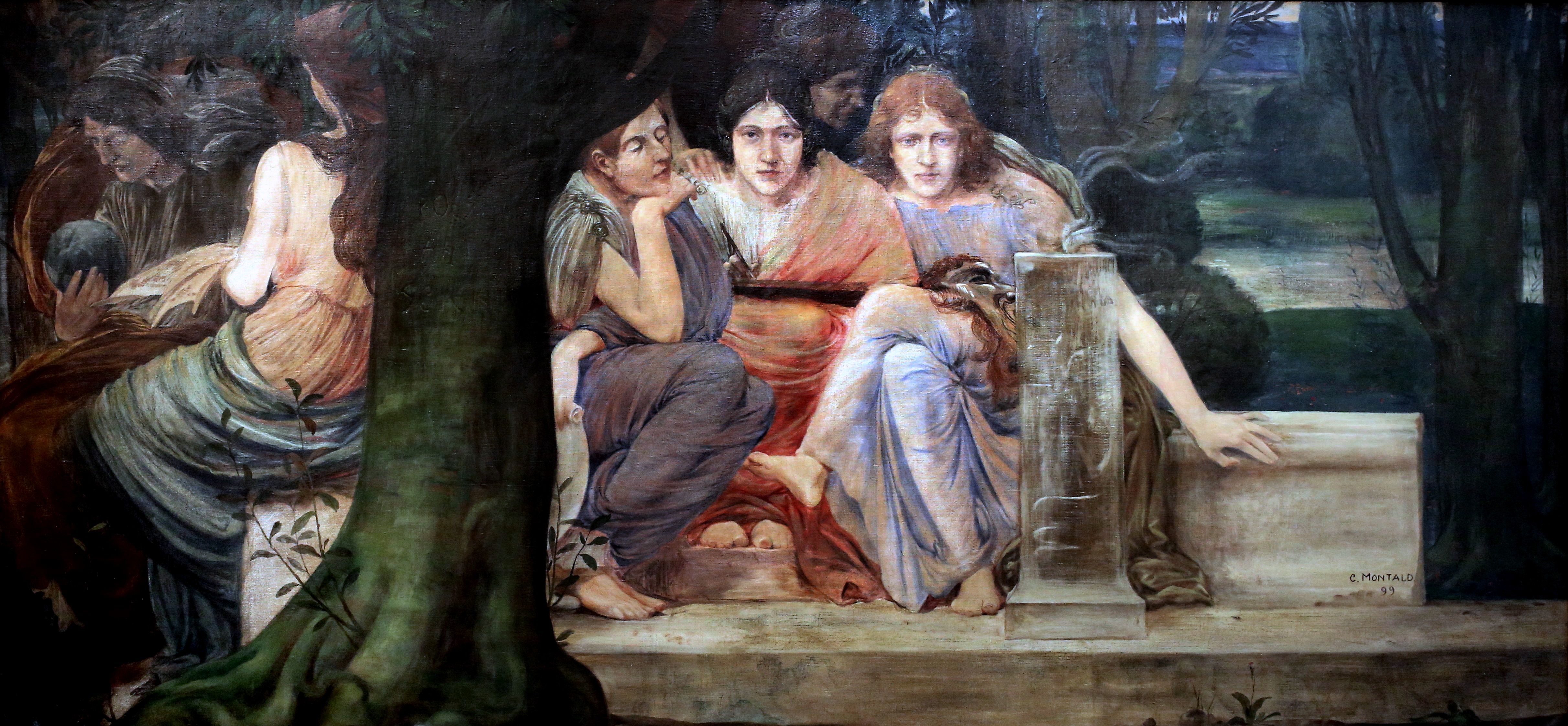|
Manaqib
''Manāqib'' (Arabic مَناقِب, also transliterated ''manāḳib''; singular مَنْقَبَ, ''manqaba/manḳaba'') is a genre in Arabic, Turkish, and Persian literature, broadly encompassing "biographical works of a laudatory nature", "in which the merits, virtues and remarkable deeds of the individual concerned are given prominence" and particularly hagiographies (biographies of holy people). The principal goal of such works "is to offer to the reader a moral portrait and information on the noble actions of the individuals who constitute their subject or on the superior merits of a certain group".Ch. Pellat, “Manāḳib”, in ''Encyclopaedia of Islam'', ed. by P. Bearman, Th. Bianquis, C.E. Bosworth, E. van Donzel, and W.P. Heinrichs, 2nd edn, 12 vols (Leiden: Brill, 1960–2005), . Such texts are valuable sources for the socio-political and religious history of early and medieval Islam.Asma Afsaruddin, 'Excellences Literature', in ''Medieval Islamic Civilization: An En ... [...More Info...] [...Related Items...] OR: [Wikipedia] [Google] [Baidu] |
Manaqib Of Ale Abi Talib
Manaqib Ale Abi Talib ( ar, مَنَاقِب آل أَبِي طَالِب ') is a book written by the Shi'a Muslim scholar Ibn Shahr Ashub. Author Abu Jafar Muhammad Ibn Ali Ibn Shahr Ashub or Ibn Shahraˆshuˆ b(489-588 lunar/1096-1192) was an Imami theologian and jurist of Mazandaran in Persia. He had the reputation of being the greatest Shiite scholar of his time and was highly thought of even by the Sunnis. he was known as Rashid Al din And Ezza Al-Din. He also wrote books such as Al Maalim. Subject The book is on virtues and characters of Muhammad, twelfth Imams, and companions of Muhammad. Motive The Author mentioned reasons for writing the book such as Challenge between Shia and Sunni on Imamate or leadership, distorted narrations by some narrators on the subject of Imamate of Ali. Authenticity The book is admired by both Shia and Sunni scholars and referred by both of them. Content Some of the contents of the book are as follow: * Section on Our Sayyed the apostl ... [...More Info...] [...Related Items...] OR: [Wikipedia] [Google] [Baidu] |
Al Saqib Fi Al-Manâqib
''Al Saqib Fi al-Manâqib'' is a book on the miracles of Muhammad, other prophets, and Shiite imams. It has also been called Saqib Al Manaqib. The book was written by Ibn Hamzeh Tousi, also known as Emad al Din Tousi, an Imami jurist in the sixth year of Hijrah. Content The book has fifteen chapters. The first focuses on Muhammad's miracles, while following chapters look at Ali, Fatimah, and Hasan Ibn Ali's miracles. The text focuses only on miracles and wonderworks (Karamat), rather than the figures' biographies. Included miracles include speaking with animals, knowledge to Absent Things, and an instance when Hasan Ibn Ali Hasan ibn Ali ( ar, الحسن بن علي, translit=Al-Ḥasan ibn ʿAlī; ) was a prominent early Islamic figure. He was the eldest son of Ali and Fatima and a grandson of the Islamic prophet Muhammad. He briefly ruled as caliph from Jan ... was able to change the sexuality of a man and a woman. Sources Some sections of the text draw from oth ... [...More Info...] [...Related Items...] OR: [Wikipedia] [Google] [Baidu] |
Literary Genre
A literary genre is a category of literature. Genres may be determined by literary technique, tone, content, or length (especially for fiction). They generally move from more abstract, encompassing classes, which are then further sub-divided into more concrete distinctions. The distinctions between genres and categories are flexible and loosely defined, and even the rules designating genres change over time and are fairly unstable. Genres can all be in the form of prose or poetry. Additionally, a genre such as satire, allegory or pastoral might appear in any of the above, not only as a subgenre (see below), but as a mixture of genres. Finally, they are defined by the general cultural movement of the historical period in which they were composed. History of genres Aristotle The concept of genre began in the works of Aristotle, who applied biological concepts to the classification of literary genres, or, as he called them, "species" (eidē). These classifications are mainl ... [...More Info...] [...Related Items...] OR: [Wikipedia] [Google] [Baidu] |
Abd Al-Rahman Al-Awza'i
Abū ʿAmr ʿAbd al-Raḥmān ibn ʿAmr al-ʾAwzāʿī ( ar, أبو عمرو عبدُ الرحمٰن بن عمرو الأوزاعي) (707–774) was an Islamic scholar, traditionalist and the chief representative and eponym of the ʾAwzāʿī school of Islamic jurisprudence. ʾAwzāʿī was referred to by his tribe "''ʾAwzā''" (الأوزاع), part of Banu Hamdan. Biography He was probably born in Baalbek (in modern-day Lebanon) in 707, although the biographer and historian Al-Dhahabi reports that Awzāʿī was originally from Sindh. Very little of al-Awzāʿī's writings survive, but his style of Islamic jurisprudence (''usul al-fiqh'') is preserved in Abu Yusuf's book ''Al-radd ʿala siyar al-Awzāʿī'', in particular his reliance on the "living tradition," or the uninterrupted practice of Muslims handed down from preceding generations. For Awzāʿī, this was the true Sunnah of Muhammad. Awzāʿī's school flourished in Syria, the Maghreb, and Al Andalus but was ... [...More Info...] [...Related Items...] OR: [Wikipedia] [Google] [Baidu] |
Sidi Mahrez
Sidi Mahrez ben Khalaf or Abu Mohamed Mahrez ben Khalaf ben Zayn ( ar, سيدي محرز بن خلف; 951–1022) was a Tunisian Wali, scholar of the Maliki school of jurisprudence and a Qadi. He is considered to be the patron-saint of the city of Tunis. Life He was born in Ariana to a father of Arab origin who traced his lineage to Abu Bakr. He studied in Kairouan and then in Fatimid-Egypt and became a teacher of Maliki jurisprudence upon his return. At the age of 57, he left his home-town (Ariana) and went into seclusion in Carthage. In c. 1014 he settled in Tunis, in a house in Bab Souika, which would become his mausoleum and later the Sidi Mahrez Mosque.« Sidi Mahrez, pour toujours », ''La Presse de Tunisie'', 17 septembre 2007 He proposed to his ... [...More Info...] [...Related Items...] OR: [Wikipedia] [Google] [Baidu] |
Abu Yazid
Abu Yazid Makhlad ibn Kaydad (; – 19 August 947), known as the Man on the Donkey (), was an Ibadi Berber of the Banu Ifran tribe who led a rebellion against the Fatimid Caliphate in Ifriqiya (modern Tunisia and eastern Algeria) starting in 944. Abu Yazid conquered Kairouan for a time, but was eventually driven back and defeated by the Fatimid caliph al-Mansur bi-Nasr Allah. Early life Abu Yazid's father Kayrad was a Zenata Berber trans-Saharan trader from Taqyus or Tozeur in the district of Chott el Djerid, then still known by its ancient name, Qastiliya. His mother Sabika was a Black African slave, bought by Kayrad at Tadmakat. Abu Yazid was born , south of the Sahara Desert, either in Gao or in Tadmakka (modern-day Essouk). Coupled with his mother's descent, this brought him the sobriquet "the Black Ethiop" (''al-Ḥabashī al-Aswad''). Abu Yazid studied the Ibadi doctrine (''madhhab'') and worked in Tahert as a schoolmaster, before moving to Takyus around 909, during ... [...More Info...] [...Related Items...] OR: [Wikipedia] [Google] [Baidu] |
Abu ʾl-Ḥasan ʿAlī Ibn Khalaf Al-Ḳābiṣī
Abu ʾl-Ḥasan ʿAlī ibn Muḥammad ibn Khalaf al-Maʿāfirī al-Qābiṣī. His ''nisba'', al-Qābiṣī (also romanized al-Ḳābisī), means "one from Qabis". Sometimes it is given as a patronymic (''nasab''), Ibn al-Qābiṣī, i.e., "son of the one from Qabis". (935–1012) was a leading Ifrīqiyan scholar ('' uṣūlī'') of the Mālikī school of Islamic jurisprudence (''fiḳh''). In 996, he succeeded his first cousin Ibn Abī Zayd as leader ('' shaykh'') of the school in al-Qayrawān (Kairouan). Al-Qābiṣī's father was born in the village of al-Maʿāfiriyyīn near Qabis (Gabès) and his mother was from al-Qayrawān. According to oral tradition, he was the first cousin of Ibn Abī Zayd and Muḥriz ibn Khalaf, the sons of his mother's sisters. He was blind. In Africa al-Qābiṣī was taught by Abu ʾl-ʿAbbās al-Ibyānī, a Shāfiʿī scholar from Tunis; Darrās al-Fāsī, an Ashʿarī; and Ibn Masrūr al-Dabbāgh. Accompanied by Darrās al-Fāsī and the ... [...More Info...] [...Related Items...] OR: [Wikipedia] [Google] [Baidu] |
Sahnun
Sahnun ibn Sa'id ibn Habib at-Tanukhi () (c. 776/77 – 854/55) (160 AH – 240 AH ) was a jurist in the Maliki school from Qayrawan in modern-day Tunisia. Biography His original name was Abdu Salaam Ibn Said Ibn Habib () He gained the nickname 'Sahnun' (a type of sharp bird) because of his quickness of mind. His father was a soldier from Homs in Syria. He was from the Arab tribe of Tanukh. Life In his youth Sahnun studied under the scholars of Qayrawan and Tunis. In particular, he learned from the Tripolitanian scholar `Ali bin Ziyad, who had learned from Imam Malik. In 178 AH he traveled to Egypt to study under other pupils of Malik, who died before Sahnun had the financial means to reach them. Later on he continued to Medina and studied under other prominent scholars, returning to North Africa in 191 AH. Upon accepting the appointment, he was said to have told his daughter Khadija, "Today your father has been slain without a knife." He was known to be scrupulous in his ju ... [...More Info...] [...Related Items...] OR: [Wikipedia] [Google] [Baidu] |
Ibn Taymiyyah
Ibn Taymiyyah (January 22, 1263 – September 26, 1328; ar, ابن تيمية), birth name Taqī ad-Dīn ʾAḥmad ibn ʿAbd al-Ḥalīm ibn ʿAbd al-Salām al-Numayrī al-Ḥarrānī ( ar, تقي الدين أحمد بن عبد الحليم بن عبد السلام النميري الحراني ),Ibn Taymiyyah, Taqi al-Din Ahmad, The Oxford Dictionary of Islam. http://www.oxfordreference.com/view/10.1093/acref/9780195125580.001.0001/acref-9780195125580-e-959 was a Sunni Muslim ʿĀlim, muhaddith, judge, proto-Salafist theologian, and sometimes controversial thinker and political figure. He is known for his diplomatic involvement with the Ilkhanid ruler Ghazan Khan and for his involvement at the Battle of Marj al-Saffar which ended the Mongol invasions of the Levant. A member of the Hanbali school, Ibn Taymiyyah's iconoclastic views that condemned numerous folk practices associated with saint veneration and the visitation of tomb-shrines made him unpopular with many schol ... [...More Info...] [...Related Items...] OR: [Wikipedia] [Google] [Baidu] |
Ahmad Ibn Hanbal
Ahmad ibn Hanbal al-Dhuhli ( ar, أَحْمَد بْن حَنْبَل الذهلي, translit=Aḥmad ibn Ḥanbal al-Dhuhlī; November 780 – 2 August 855 CE/164–241 AH), was a Muslim jurist, theologian, ascetic, hadith traditionist, and founder of the Hanbali school of Sunni jurisprudence — one of the four major orthodox legal schools of Sunni Islam. A highly influential and active scholar during his lifetime,H. Laoust, "Ahmad b. Hanbal," in ''Encyclopedia of Islam'', Vol. I, pp. 272-7 Ibn Hanbal went on to become "one of the most venerated" intellectual figures in Islamic history, who has had a "profound influence affecting almost every area of" the traditionalist perspective within Sunni Islam.Holtzman, Livnat, “Aḥmad b. Ḥanbal”, in: Encyclopaedia of Islam, THREE, Edited by: Kate Fleet, Gudrun Krämer, Denis Matringe, John Nawas, Everett Rowson. One of the foremost classical proponents of relying on scriptural sources as the basis for Sunni Islamic law and ... [...More Info...] [...Related Items...] OR: [Wikipedia] [Google] [Baidu] |


